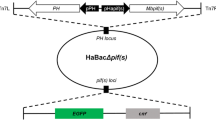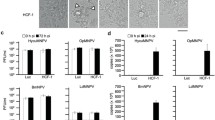Abstract
An isolate of the Spodoptera frugiperda multiple nucleopolyhedrovirus comprises a stable proportion of deletion genotypes (e.g., SfNIC-C), that lack pif1 and pif2 rendering them noninfectious per os, and that survive by complementation with a complete genotype (SfNIC-B) in coinfected cells. To determine whether selection for particular ratios of complete and deletion genotypes occurs mainly during the establishment of the primary infection in insect midgut cells or during subsequent systemic infection, we examined genotype frequencies in insects that fed on OBs comprising different co-occluded mixtures of genotypes. Dramatic changes in genotype frequencies were observed between the OB inoculum and budded virus (BV) samples taken from larvae inoculated with OBs comprising 10% SfNIC-B + 90% SfNIC-C indicating that a marked reduction of SfNIC-C genotype had occurred in the insect midgut due to the immediate elimination of all OBs that originated from cells that had been infected only by SfNIC-C. In contrast, immediate changes were not observed in OBs comprising mixtures of 50% SfNIC-B + 50% SfNIC-C or those comprising 10% SfNIC-B + 90% SfNIC-C as most of the OBs in these mixtures originated from cells that had been infected by both genotypes. Subsequent changes in genotypic frequencies during five days of systemic infection were fairly small in magnitude for all genotypic mixtures. We conclude that the prevalence of defective genotypes in the SfNIC population is likely determined by a balance between host selection against OBs produced in cells infected by SfNIC-C alone and within-host selection for fast-replicating deletion genotypes. The strength of intra-host selection is likely modulated by changes in MOI during the infection period.
Similar content being viewed by others
References
Bull J C, Godfray H C J, O’Reilly D R. 2003. A few-polyhedra mutant and wild-type nucleopolyhedrovirus remain as a stable polymorphism during serial coinfection in Trichoplusia ni. Appl Environ Microbiol, 69: 2052–2057.
Bull J C, Godfray H C J, O’Reilly D R. 2001. Persistence of an occlusion-negative recombinant nucleopolyhedrovirus in Trichoplusia ni indicates high multiplicity of cellular infection. Appl Environ Microbiol 67: 5204–5209.
Clavijo G, Williams T, Simón O,et al. 2009 Mixtures of complete and pif1- and pif2-deficient genotypes are required for increased potency of an insect nucleopolyhedrovirus. J Virol, 83: 5127–5136.
Cooper D, Cory J S, Myers J H. 2003. Hierarchical spatial structure of genetically variable nucleopolyhedro-viruses infecting cyclic populations of western tent caterpillars. Mol Ecol, 12: 881–890.
Cory J S, Green B M, Paul R K,et al. 2005. Genotypic and phenotypic diversity of a baculovirus population within an individual insect host. J Invertebr Pathol, 89: 101–111.
Escribano A, Williams T, Goulson D,et al. 1999. Selection of a nucleopolyhedrovirus for control of Spodoptera frugiperda (Lepidoptera: Noctuidae): Structural, genetic, and biological comparison of four isolates from the Americas. J Econ Entomol, 92: 1079–1085.
Greene G L, Leppla N C, Dickerson W A. 1976. Velvetbean caterpillar: a rearing procedure and artificial medium. J Econ Entomol, 69: 487–488.
Gutiérrez S, Kikhno I, López-Ferber M. 2004. Transcription and promoter analysis of pif, an essential but low-expressed baculovirus gene. J Gen Virol, 85: 331–341.
Hamblin M, van Beek N A M, Hughes PR,et al. 1990. Co-occlusion and persistence of a baculovirus mutant lacking the polyhedrin gene. Appl Environ Microbiol, 56: 3057–3062.
Hitchman R B, Hodgson D J, King L A,et al. 2007. Host mediated selection of pathogen genotypes as a mechanism for the maintenance of baculovirus diversity in the field. J Invertebr Pathol, 94: 153–162.
Hodgson D J, Hitchman R B, Vanbergen A J,et al. 2004. Host ecology determines the relative fitness of virus genotypes in mixed-genotype nucleopolyhedrovirus infections. J Evol Biol, 17: 1018–1025.
Hodgson D J, Vanbergen A J, Watt A D,et al. 2001. Phenotypic variation between naturally coexisting genotypes of a Lepidopteran baculovirus. Ecol Evol Res, 3: 687–701.
Hughes P R, Wood H A. 1981. A synchronous peroral technique for the bioassay of insect viruses. J Invertebr Pathol, 37: 154–159.
Kikhno I, Gutiérrez S, Croizier L,et al. 2002. Characterization of pif, a gene required for the per os infectivity of Spodoptera littoralis nucleopolyhedrovirus. J Gen Virol, 83: 3013–3022.
Knell J D, Summers M D. 1981. Investigation of genetic heterogeneity in wild isolates of Spodoptera frugiperda nuclear polyhedrosis virus by restriction endonuclease analysis of plaque-purified variants. Virology, 112: 190–197.
Kuzio J, Jaques R, Faulkner P. 1989. Identification of p74, a gene essential for virulence of baculovirus occlusion bodies. Virology, 173: 759–763.
Lapointe R, Popham H J R, Straschil U,et al. 2004. Characterization of two Autographa californica nucleopolyhedrovirus proteins, Ac145 and Ac150, which affect oral infectivity in a host-dependent manner. J Virology, 78: 6439–6448.
Lee H H, Miller L K. 1978. Isolation of genotypic variants of Autographa californica nuclear polyhedrosis virus. J Virol, 27: 754–767.
López-Ferber M, Simón O, Williams T,et al. 2003. Defective or effective? Mutualistic interactions between virus genotypes. Proc Biol Sci, 270: 2249–2255.
Muñoz D, Murillo R, Krell P J,et al. 1999. Four genotypic variants of a Spodoptera exigua nucleopolyhedrovirus (Se-SP2) are distinguishable by a hypervariable genomic region. Virus Res, 59: 61–74.
Ohkawa T, Washburn J O, Sitapara R,et al. 2005. Specific binding of Autographa californica M nucleopolyhedrovirus occlusion-derived virus to midgut cells of Heliothis virescens larvae is mediated by products of pif genes Ac119 and Ac022 but not by Ac115. J Virol, 79: 15258–15264.
Parnell M, Grzywacz D, Jones K A,et al. 2002. The strain variation and virulence of granulovirus of diamond-back moth (Plutella xylostella Linnaeus, Lep, Yponomeutidae) isolated in Kenya. J Invertebr Pathol, 79: 192–196.
Pijlman G P, Pruijssers A J, Vlak J M. 2003. Identification of pif-2, a third conserved baculovirus gene required for per os infection of insects. J Gen Virol, 84: 2041–2049.
Simón O, Williams T, Caballero P,et al. 2006. Dynamics of deletion genotypes in an experimental insect virus population. Proc Biol Sci, 273: 783–790.
Simón O, Williams T, López-Ferber M,et al. 2005. Functional importance of deletion mutant genotypes in an insect nucleopolyhedrovirus population. Appl Environ Microbiol, 71: 4254–4262.
Simón O, Williams T, López-Ferber M,et al. 2004. Genetic structure of a Spodoptera frugiperda nucleopolyhedrovirus population: high prevalence of deletion genotypes. Appl Environ Microbiol, 70: 5579–5588.
Simón O, Williams T, López-Ferber M,et al. 2008. Population genetic structure determines speed of kill and occlusion body production in Spodoptera frugiperda multiple nucleopolyhedrovirus. Biol Control, 44: 321–330.
Smith I R, Crook N E. 1988. In vivo isolation of baculovirus genotypes. Virology, 166: 240–244.
Song J J, Wang R R, Deng F,et al. 2008. Functional studies of per os infectivity factors of Helicoverpa armigera single nucleocapsid nucleopolyhedrovirus. J Gen Virol, 89: 2331–2338.
Yao L G, Zhou W K, Xu H,et al. 2004. The Heliothis armigera single nucleocapsid nucleopolyhedrovirus envelope protein P74 is required for infection of the host midgut. Virus Res, 104: 111–121.
Zhang J H, Ohkawa T, Washburn J O,et al. 2005. Effects of Ac150 on virulence and pathogenesis of Autographa californica multiple nucleopolyhedrovirus in noctuid hosts. J Gen Virol, 86: 1619–1627.
Zhou W K, Yao L G, Xu H,et al. 2005. The function of envelope protein P74 from Autographa californica multiple nucleopolyhedrovirus in primary infection to host. Virus Genes, 30: 139–150.
Zwart M P, Erro E, van Oers M M,et al. 2008. Low multiplicity of infection in vivo results in purifying selection against baculovirus deletion mutants. J Gen Virol, 89: 1220–1224.
Author information
Authors and Affiliations
Corresponding author
Additional information
Foundation items: This study was funded by MEC projects numbers AGL2005-07909-CO3-01 and AGL2008-05456-CO3-01/AGR
Rights and permissions
About this article
Cite this article
Clavijo, G., Williams, T., Muñoz, D. et al. Entry into midgut epithelial cells is a key step in the selection of genotypes in a nucleopolyhedrovirus. Virol. Sin. 24, 350–358 (2009). https://doi.org/10.1007/s12250-009-3048-x
Received:
Accepted:
Published:
Issue Date:
DOI: https://doi.org/10.1007/s12250-009-3048-x




